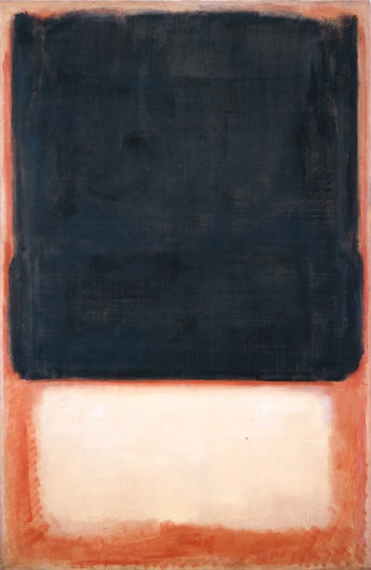Mark Rothko’s monumental canvas,

Mark Rothko, No. 7 (Dark Over Light), 1954, oil on canvas, 90 ⅛ x 58 ⅝ in. © Christie’s Images Limited 2018.No. 7 (Dark Over Light), 1954, will highlight Christie's May 17 Evening Sale of Post-War and Contemporary Art in New York (estimate in the region of $30 million). At nearly eight feet tall, No. 7 (Dark Over Light) belongs to a select group of canvases that were among the largest that Rothko ever painted. Its grand scale is matched only by the emotional intensity of its painted surface. Such a highly active painterly surface is a mark of Rothko’s paintings from this important period, but it is the scale on which it has been executed in No. 7 (Dark Over Light) that makes this particular work one of the most extraordinary; its broad sweeps and feathered edges reveal the artist’s ambition to create a pure and direct form of painting. No. 7 (Dark Over Light) is being offered at auction for the first time in over a decade.
Jussi Pylkkänen, Christie’s Global President, remarked: “No. 7 (Dark Over Light), comes from a small and highly sought-after group of monumental canvases by Mark Rothko. Standing before this radiant picture, one is immediately enveloped by the dramatic brilliance of Rothko’s artistic vision. Between its intensely kinetic surface and its epic scale, No. 7 is a consummate example of Rothko’s ability to convey pure emotional power. Given the international demand for canvases of this quality by Mark Rothko, we expect that No. 7 will draw enthusiasm from collectors around the globe."
Rothko’s stated aim was to dissolve the traditional, and what he thought of as artificial boundaries, between paint and canvas, between painter and idea, and ultimately between the idea and the observer. To the artist, what the viewer saw was not a depiction an experience, it was the experience, and to this end he championed what he considered to be the two fundamental elements of picture making—space and color—making these the sole protagonists of his aesthetic drama. Reaching its height in his iconic Seagram Murals, this painterly struggle dominated Rothko’s work for a little over a decade, as in 1968, on the instructions of his doctors, he was forced to retreat into making smaller paintings, often no larger than 40 inches. As a result, works such No. 7 (Dark Over Light) represents the fullest and purest expression of Rothko’s unique artistic vision, one whose visual and emotional power is present in abundance in this magisterial canvas.
No. 7 (Dark Over Light) belongs to a small group of paintings that Rothko executed in the mid-1950s which feature large passages of predominately dark, moody color. Primarily, his paintings from this period are known for the triumphant schema of fiery reds, golden yellows and deep oranges. But in a handful of canvases he also introduced opposing hues, such as can be seen in the present work along with Untitled (Violet, Black, Orange on Gray), 1953 (National Gallery of Art Washington), No. 203 (Red, Orange, Tan and Purple), 1954 and Untitled (Red, Black, White on Yellow), 1955 (also in the collection of the National Gallery of Art, Washington, D.C.). These dark paintings reflected not so much a "darkening" of Rothko's mood as a deepening of feeling.
In addition to color, size was also an important factor in Rothko achieving the necessary emotional intensity that he desired. As he explained, “I paint very large pictures. I realize that historically the function of painting large pictures is painting something very grandiose and pompous. The reason I paint them, however—I think it applies to other painters I know—it is precisely because I want to be very intimate and human. To paint a small picture is to place yourself outside you experience, to look upon an experience as a stereopticon view or with a reducing glass. However, you paint the larger picture, you are in it. It isn’t something you command.”
No. 7 (Dark Over Light) was first acquired by Count Alessandro Panza di Biumo, Sr. in 1961. He was the brother of the legendary Count Giuseppe Panza di Biumo, widely considered to be one of the most important collectors of postwar American Art. Works from the elder Panza di Biumo’s holdings later formed the basis for the collection of the Los Angeles Museum of Contemporary Art, and in the 1990s, the Solomon R. Guggenheim Museum filled a yawning gap in its holdings when it acquired, in a combined gift and purchase arrangement, more than 300 Minimalist sculptures and paintings from the collection.
Among the Post-War Highlights is Willem de Kooning’s Untitled XVIII, 1976. Distinguished by its lavishly painted surface and riotous palette, Untitled XVIII
epitomizes de Kooning’s last great cycle of “pastoral” paintings that
ushered forth from the artist in a final flourish between the years 1976
and 1977. Widely considered to be among his best work, these
large-scale landscapes—with Untitled XVIII a seminal
example—evoke the bucolic splendor of the artist’s East Hampton studio
at Springs. In exuberant strokes of effervescent, translucent paint, de
Kooning captures and distills the essence of the seaside hamlet.
Penetrated by an inner glow, the painting evokes the specific character
of North Atlantic light, making it a harmonious ballet of color, form
and gesture. Having featured in the seminal debut of de Kooning’s
“pastoral” paintings at the Solomon R. Guggenheim in 1978, Untitled XVIII
belongs to a select group of only about twenty paintings that the
artist deemed worthy of exhibition, in what would be his first solo
museum show in New York in nine years. Estimate: $8-12 million.